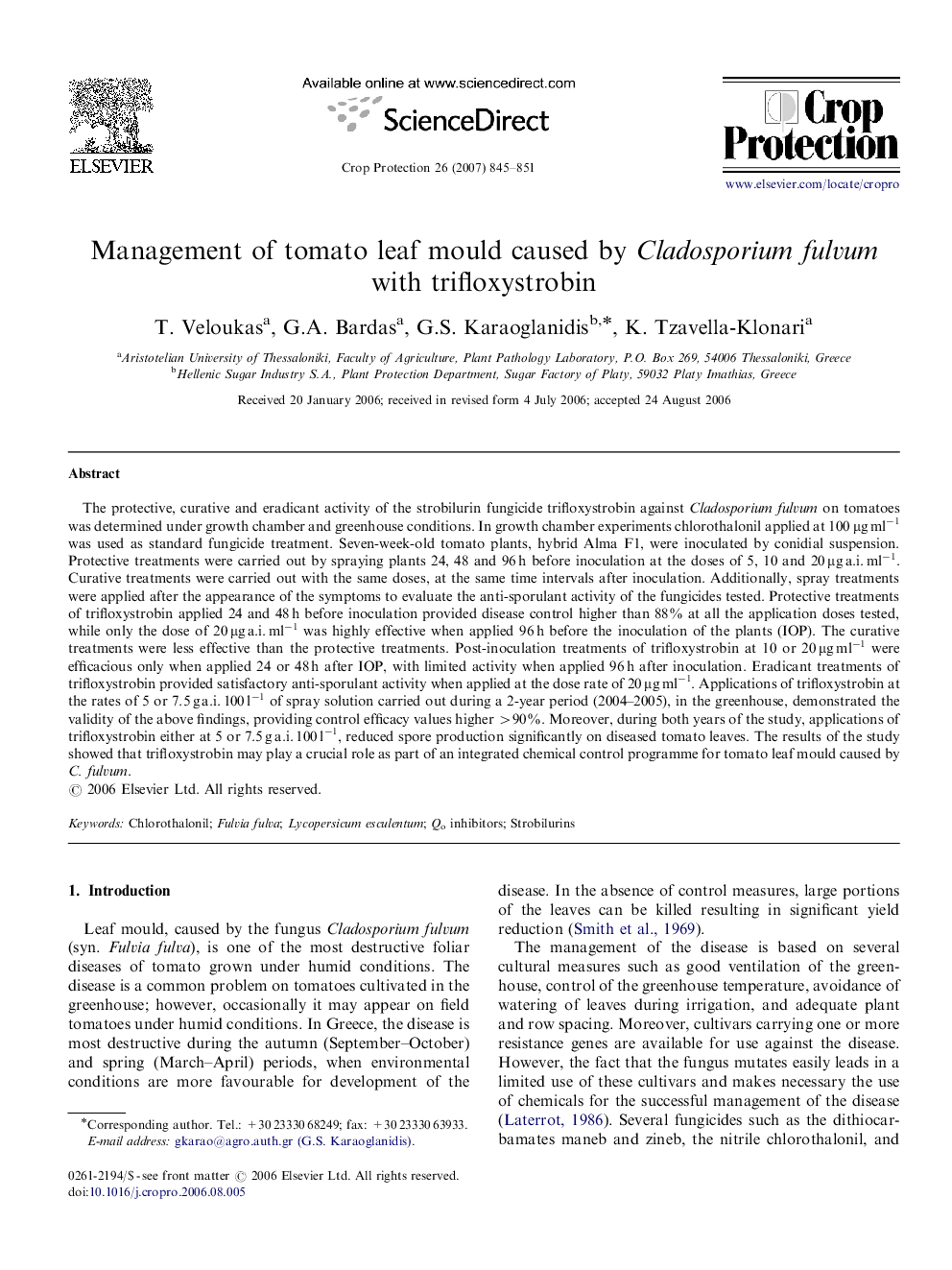| کد مقاله | کد نشریه | سال انتشار | مقاله انگلیسی | نسخه تمام متن |
|---|---|---|---|---|
| 4507740 | 1321381 | 2007 | 7 صفحه PDF | دانلود رایگان |
عنوان انگلیسی مقاله ISI
Management of tomato leaf mould caused by Cladosporium fulvum with trifloxystrobin
دانلود مقاله + سفارش ترجمه
دانلود مقاله ISI انگلیسی
رایگان برای ایرانیان
موضوعات مرتبط
علوم زیستی و بیوفناوری
علوم کشاورزی و بیولوژیک
علوم زراعت و اصلاح نباتات
پیش نمایش صفحه اول مقاله

چکیده انگلیسی
The protective, curative and eradicant activity of the strobilurin fungicide trifloxystrobin against Cladosporium fulvum on tomatoes was determined under growth chamber and greenhouse conditions. In growth chamber experiments chlorothalonil applied at 100 μg mlâ1 was used as standard fungicide treatment. Seven-week-old tomato plants, hybrid Alma F1, were inoculated by conidial suspension. Protective treatments were carried out by spraying plants 24, 48 and 96 h before inoculation at the doses of 5, 10 and 20 μg a.i. mlâ1. Curative treatments were carried out with the same doses, at the same time intervals after inoculation. Additionally, spray treatments were applied after the appearance of the symptoms to evaluate the anti-sporulant activity of the fungicides tested. Protective treatments of trifloxystrobin applied 24 and 48 h before inoculation provided disease control higher than 88% at all the application doses tested, while only the dose of 20 μg a.i. mlâ1 was highly effective when applied 96 h before the inoculation of the plants (IOP). The curative treatments were less effective than the protective treatments. Post-inoculation treatments of trifloxystrobin at 10 or 20 μg mlâ1 were efficacious only when applied 24 or 48 h after IOP, with limited activity when applied 96 h after inoculation. Eradicant treatments of trifloxystrobin provided satisfactory anti-sporulant activity when applied at the dose rate of 20 μg mlâ1. Applications of trifloxystrobin at the rates of 5 or 7.5 g a.i. 100 lâ1 of spray solution carried out during a 2-year period (2004-2005), in the greenhouse, demonstrated the validity of the above findings, providing control efficacy values higher >90%. Moreover, during both years of the study, applications of trifloxystrobin either at 5 or 7.5 g a.i. 100 lâ1, reduced spore production significantly on diseased tomato leaves. The results of the study showed that trifloxystrobin may play a crucial role as part of an integrated chemical control programme for tomato leaf mould caused by C. fulvum.
ناشر
Database: Elsevier - ScienceDirect (ساینس دایرکت)
Journal: Crop Protection - Volume 26, Issue 6, June 2007, Pages 845-851
Journal: Crop Protection - Volume 26, Issue 6, June 2007, Pages 845-851
نویسندگان
T. Veloukas, G.A. Bardas, G.S. Karaoglanidis, K. Tzavella-Klonari,